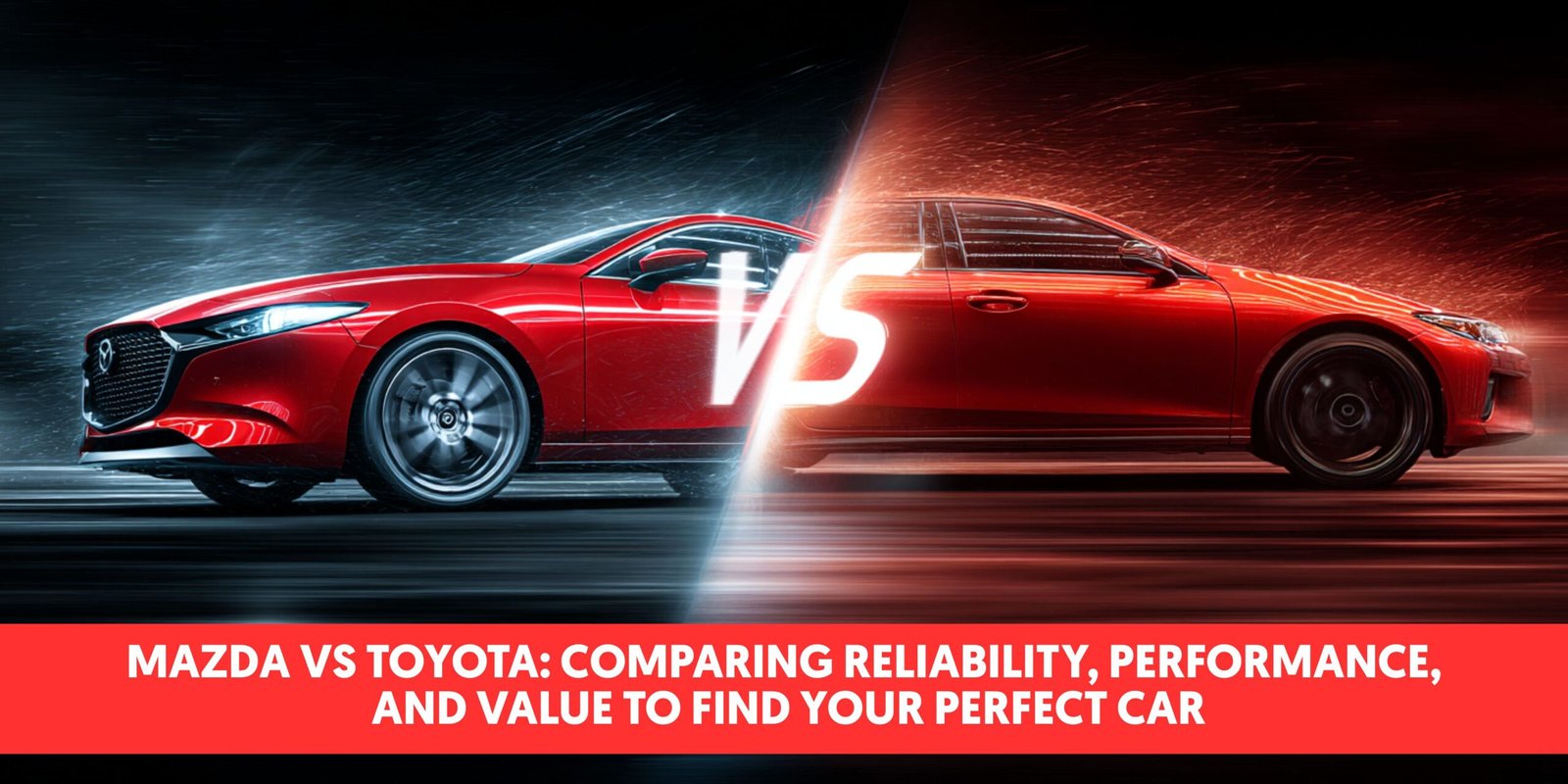Are you torn between Mazda and Toyota for your next vehicle purchase? You’re not alone. These two Japanese automotive powerhouses have dominated the market with their reliable, efficient, and innovative vehicles for decades.
While Toyota has built its reputation on unmatched reliability and resale value, Mazda has carved out its niche with sporty handling and premium designs at competitive prices. In this head-to-head comparison, we’ll explore how these manufacturers stack up in performance, reliability, safety features, and overall value to help you make the right choice for your driving needs and preferences.
Mazda vs Toyota: Brand Overview
When comparing Mazda vs Toyota, you’re looking at two Japanese automotive giants with distinct brand identities. Toyota has built its reputation on reliability, practicality, and mass-market appeal since its founding in 1937. The company prioritizes dependability and efficiency in its vehicle lineup, making Toyota cars famous for lasting well beyond 200,000 miles with proper maintenance.
Mazda offers a different approach to the automotive market. Established in 1920 first as a cork manufacturer before transitioning to vehicles, Mazda positions itself as a more premium alternative that doesn’t command luxury prices. The brand emphasizes driving dynamics with their “Zoom-Zoom” philosophy and later “Driving Matters” campaigns that highlight their focus on driver engagement and enjoyment.
Toyota boasts a broader vehicle lineup spanning nearly every segment from compact cars to full-size trucks and luxury vehicles through its Lexus division. Their hybrid technology pioneered by the Prius has given them a strong foothold in the eco-friendly vehicle market. Mazda’s portfolio is more concentrated on passenger cars and crossovers with a distinct emphasis on styling and driving experience.
The design philosophy between these brands shows clear differences. Toyota typically creates vehicles with broad appeal and functional designs, while Mazda employs their “Kodo: Soul of Motion” design language to create more visually striking vehicles. This approach has earned Mazda recognition for producing some of the most attractive mainstream vehicles available today.
Market position reveals another contrast between these manufacturers. Toyota consistently ranks among the top-selling brands globally with enormous production capacity and widespread dealer networks. Mazda operates as a smaller manufacturer with a more focused product line that appeals to drivers seeking something different from the mainstream options.
Performance Comparison
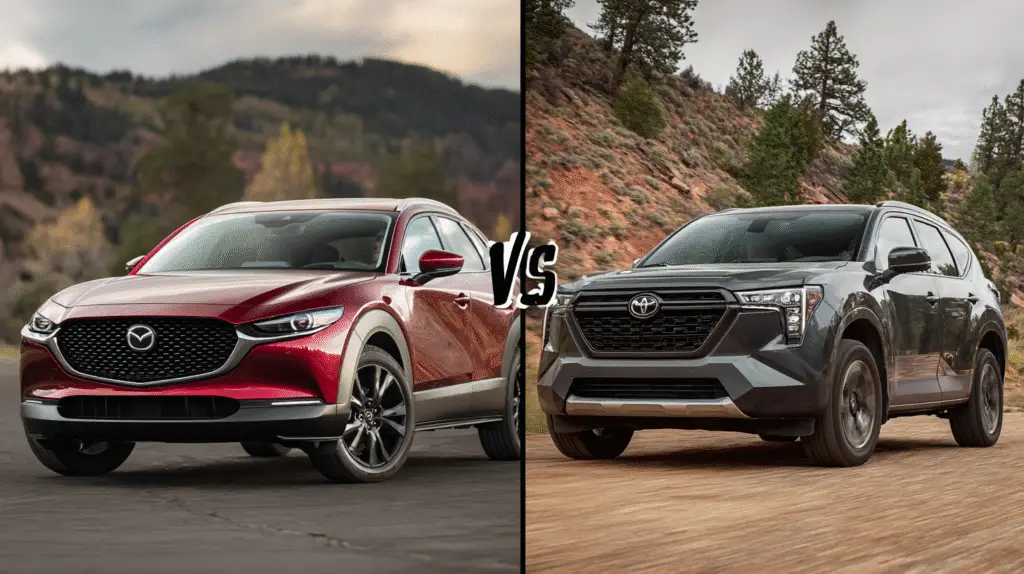
When comparing Mazda vs Toyota performance, distinct driving philosophies become evident. Mazda emphasizes an captivating, thrilling driving experience with sport-tuned suspension and driver-centric features. Toyota takes a different approach by focusing on reliability, comfort, and fuel efficiency which results in a softer ride quality.
Engine Power and Efficiency
Mazda’s innovative Skyactiv® technology creates an impressive balance between power and fuel efficiency without heavy reliance on turbocharging in most of their engines. Their turbocharged variants available in SUV models like the CX-5, CX-50, and CX-90 deliver superior horsepower and torque compared to similar Toyota models. Mazda’s turbocharged engines can reach up to 340 hp while Toyota’s comparable models typically offer around 203 hp for vehicles like the RAV4.
Toyota excels with their hybrid powertrains which are renowned for exceptional fuel economy and reliability. These efficient systems prioritize long-term dependability over sporty acceleration. Mazda engines generally deliver greater handling capability and bursts of power that enthusiasts appreciate. Toyota engines have earned a legendary status for durability and longevity that practical buyers value.
Handling and Driving Experience
Mazda offers sport-tuned suspensions and tighter steering response across their lineup. Many Mazda models come with i-Activ AWD® as standard equipment which enhances traction and driver confidence in various road conditions. The cockpit-style, driver-focused interior design further enhances the engagement between driver and vehicle.
Toyota vehicles feature more comfort-oriented handling characteristics with a softer ride quality. Their models typically offer AWD as an optional feature on higher trims rather than as standard equipment. Toyota prioritizes stability and passenger comfort over sportiness in their suspension tuning and overall driving dynamics.
Driving enthusiasts often prefer Mazda for its spirited, connected driving experience that makes everyday commutes more enjoyable. Toyota appeals to practical drivers seeking reliable transportation with minimal fuss and maximum comfort for all passengers.
Transmission Options
Mazda generally employs conventional automatic transmissions that are finely tuned for responsiveness. They intentionally avoid continuously variable transmissions (CVTs) in most models which provides a more direct and captivating feel during acceleration. Mazda continues to offer six-speed manual transmissions in some models like the Mazda3—a feature that has become increasingly rare in modern vehicles.
Toyota utilizes CVTs in many of their popular models to maximize fuel efficiency. While this transmission type helps achieve impressive fuel economy numbers, some drivers find the “rubber-band” acceleration feel less captivating. Toyota has gradually removed most manual transmission options from their lineup as they focus on efficiency and ease of use over driver engagement.
| Aspect | Mazda | Toyota |
|---|---|---|
| Performance Focus | Sporty, captivating drive with sport-tuned suspension | Reliable, smooth, comfort-focused ride |
| Engine Power | Skyactiv technology with turbo options up to 340 hp | Wide range with strong hybrids but lower peak power |
| Fuel Efficiency | Balanced approach to efficiency and power | Excellent hybrid fuel economy |
| Handling | Tight, agile handling with i-Activ AWD standard on many models | Softer ride quality with AWD often optional |
| Transmission | Conventional automatics with manual options available | Mostly CVTs with manual transmissions largely discontinued |
Design and Build Quality
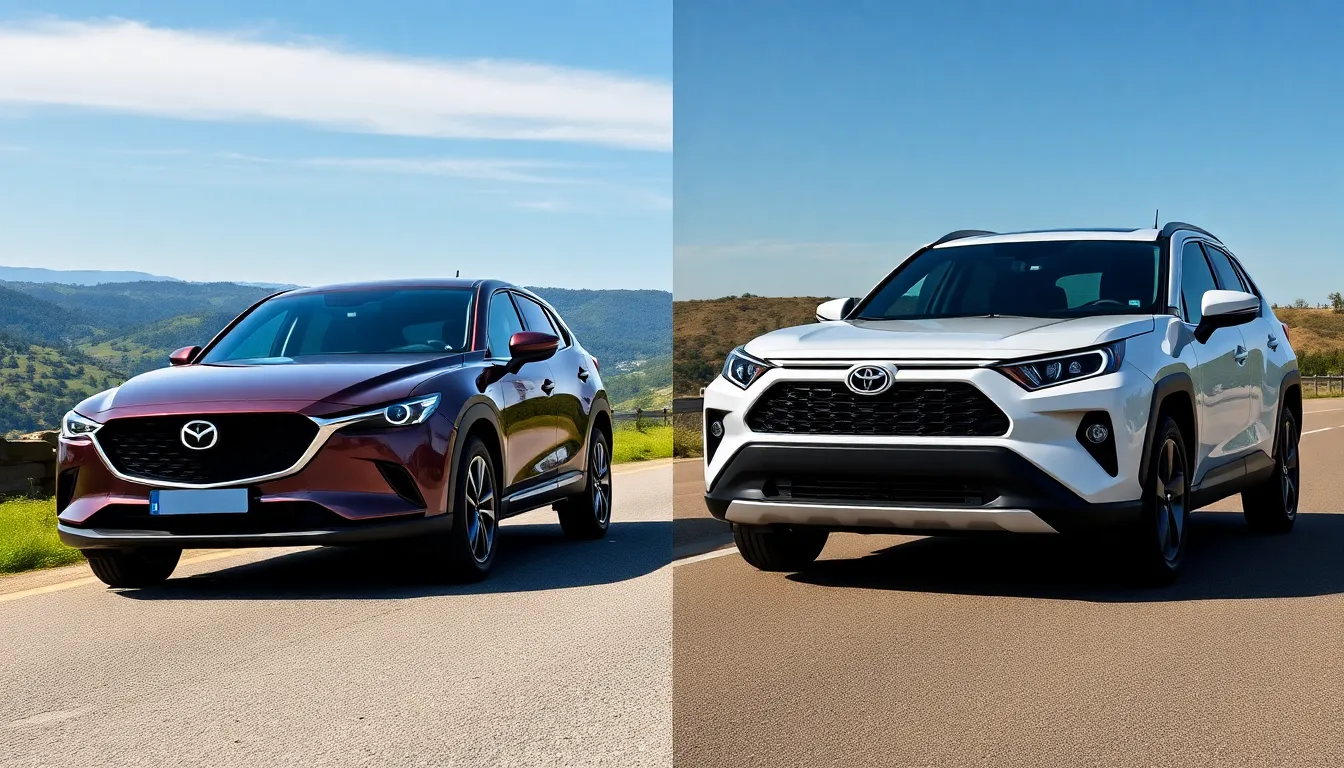
When comparing Mazda vs Toyota, their design philosophies and build quality showcase distinctly different approaches that reflect each brand’s core values. These differences extend from their exterior styling to interior comfort and overall reliability.
Exterior Styling
Mazda vehicles stand out with their aggressive yet elegant exterior designs that embody the brand’s “Kodo: Soul of Motion” design language. The CX-50 exemplifies this approach, combining rugged aesthetics with luxury cues that give Mazda vehicles a more premium appearance on the road. You might notice the more sculpted body lines and attention to proportions that create a sense of motion even when the vehicle is stationary. Some critics point to excessive black plastic cladding around wheel arches as a minor drawback in certain Mazda models.
Toyota takes a more practical and family-friendly approach to exterior styling. Their designs prioritize functionality over flair with well-recognized aesthetics that appeal to a broad audience. Toyota vehicles typically feature more conservative styling elements that stand the test of time rather than chasing current trends. This approach has helped Toyota maintain consistent brand recognition across their diverse vehicle lineup.
Interior Comfort and Materials
Mazda interiors deliver an upscale feel that often surprises first-time buyers expecting mainstream quality. You’ll find leather upholstery and leather-padded dashboards even in mid-tier models that create a premium tactile experience. The minimalist and refined cockpit design focuses on driver engagement with thoughtfully placed controls and high-quality infotainment systems that rival European luxury vehicles. This attention to detail makes even entry-level Mazda models feel more luxurious compared to similarly priced competitors.
Toyota interiors emphasize functionality and durability over luxury appointments. While perfectly serviceable and built to last for years of family use, Toyota cabins often feature more basic materials and designs, particularly in their lower-priced models. The focus remains on practical layouts, intuitive controls, and comfortable seating rather than creating a premium atmosphere. This practical approach aligns with Toyota’s reputation for vehicles that prioritize long-term reliability over initial impressions.
Build Reliability
Both Mazda and Toyota have established strong reputations for reliability, though recent assessments give Mazda a slight edge. According to Consumer Reports studies, Mazda achieved an 83 reliability score compared to Toyota’s 74, with Mazda vehicles having only a 10% chance of requiring major repairs versus Toyota’s 12%. This narrow advantage represents Mazda’s commitment to quality engineering even though their smaller production scale.
Toyota maintains its legendary status for long-term dependability with vehicles routinely lasting well beyond 200,000 miles with proper maintenance. Their manufacturing process incorporates both human craftsmanship and automated precision, adhering to principles like Jidoka and Kaizen that ensure consistent quality. Toyota also leads in safety ratings, with more vehicles achieving IIHS Top Safety Pick+ status, though Mazda also performs admirably in safety assessments while maintaining their sportier character.
Technology and Features
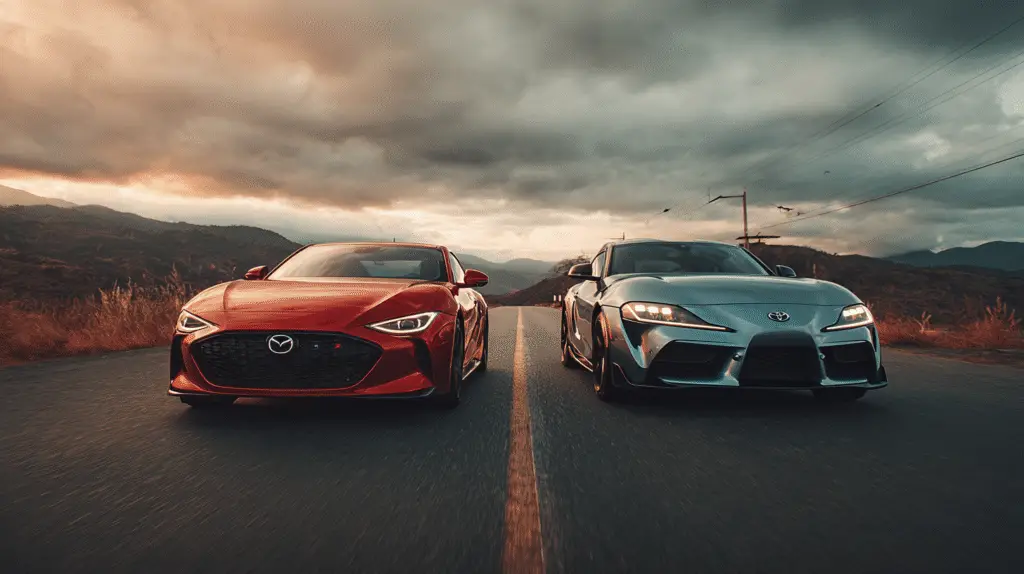
When comparing Mazda vs Toyota, their approach to technology integration reveals important differences in philosophy and execution. Mazda prioritizes premium experiences with intuitive interfaces, while Toyota focuses on practical functionality with recent important improvements.
Infotainment Systems
Mazda’s infotainment experience centers around the sophisticated Mazda Connect™ system, featuring expansive 10.25 to 12.3-inch high-resolution displays that dominate the dashboard. Unlike many competitors, Mazda employs a command knob controller positioned between the front seats, allowing drivers to navigate menus without removing their eyes from the road. Audio quality stands out in Mazda vehicles equipped with the available 12-speaker Bose® premium sound system, delivering rich, immersive sound throughout the cabin. Many Mazda models also offer Head-Up Display technology that projects critical driving information directly onto the windshield, keeping essential data within your natural line of sight.
Toyota has substantially upgraded its infotainment offerings in recent model years, particularly in 2022 and 2023 vehicles. The latest systems feature responsive touchscreens with vibrant graphics and improved user interfaces. Toyota’s newest infotainment platforms support lightning-fast Bluetooth pairing, advanced driver preference memory settings, and smoother overall operation. These improvements have rolled out across popular models including the Corolla, RAV4, Highlander, and the all-electric bZ4X, demonstrating Toyota’s commitment to modernizing its technology offerings.
Driver Assistance Features
Both manufacturers offer comprehensive driver assistance packages, though their implementation reflects their distinct brand identities. Mazda’s i-Activsense safety technology suite integrates seamlessly with the driving experience, providing alerts and interventions that feel natural and unobtrusive. The systems prioritize driver engagement while still delivering the protection of features like Smart Brake Support, Lane Departure Warning, and Mazda Radar Cruise Control with Stop and Go functionality.
Toyota pioneered mainstream advanced safety systems with its Toyota Safety Sense package, which comes standard across virtually the entire model lineup. Toyota’s approach emphasizes broad accessibility, ensuring that even entry-level models receive sophisticated safety technology. The Pre-Collision System with Pedestrian Detection, Lane Departure Alert with Steering Assist, and Ever-changing Radar Cruise Control work together to create multiple layers of protection. Toyota’s systems tend to be more assertive in their interventions, prioritizing maximum safety over subtlety.
Connectivity Options
Connectivity represents another area where the brands have evolved significantly in recent years. Mazda emphasizes wireless integration with smartphones, offering seamless Apple CarPlay and Android Auto compatibility across most models. The command knob interface specifically aims to reduce driver distraction while still providing full access to your digital life. Mazda’s over-the-air update capability ensures that software improvements arrive automatically, keeping vehicles technologically current throughout ownership.
Toyota has made tremendous strides in connectivity, particularly with its latest generation systems. Modern Toyota vehicles feature faster pairing and reconnection times when linking smartphones, reducing the frustration of waiting for systems to sync. Wireless Apple CarPlay and Android Auto have become increasingly available across the lineup, eliminating the need for cables. Toyota’s latest infotainment platforms also support over-the-air updates, ensuring that functionality can improve over time without requiring dealer visits.
| Feature | Mazda | Toyota |
|---|---|---|
| Infotainment Screen Size | 10.25–12.3 inches, high-resolution | Varies by model, latest systems updated 2022–2023 |
| Audio System | Available 12-speaker Bose® premium audio | Standard audio, varies by trim level |
| User Interface | Command knob + touchscreen, HUD available | Responsive touchscreen, wireless CarPlay/Android Auto |
| Cabin Quality | Premium materials, enhanced sound insulation | Functional interiors, practical design approach |
| Connectivity | Wireless Apple CarPlay/Android Auto, OTA updates | Wireless Apple CarPlay/Android Auto, OTA updates |
| Driver Assistance | Advanced features with natural integration | Toyota Safety Sense, comprehensive protection |
Safety Ratings and Features

When comparing Mazda vs Toyota, safety performance stands as a critical factor for many car buyers. Both manufacturers have established strong reputations for building vehicles that protect their occupants, though they approach safety engineering with slightly different philosophies.
Crash Test Results
Mazda vehicles consistently earn impressive safety ratings from major testing organizations. Every model in Mazda’s lineup has garnered high marks, with many receiving the coveted Top Safety Pick awards from the Insurance Institute for Highway Safety (IIHS). The Mazda CX-5, for example, demonstrates exceptional crashworthiness with strong ratings across all test categories. Looking ahead, the new Mazda CX-90 is anticipated to achieve similarly high IIHS and National Highway Traffic Safety Administration (NHTSA) ratings. The brand’s commitment to safety manifests through robust build quality and structural integrity in crash scenarios.
Toyota also maintains an excellent safety record with many models receiving top honors. Popular vehicles like the Toyota Camry and RAV4 consistently score well in IIHS and NHTSA evaluations. You should note that some Toyota models built on older platforms, such as the 4Runner, may not perform as impressively in certain crash tests compared to Mazda’s newer designs. Nevertheless, Toyota’s overall safety engineering continues to earn consumer trust across its diverse vehicle lineup.
| Brand | Crash Test Performance | IIHS Recognition |
|---|---|---|
| Mazda | High scores across all test categories | Multiple Top Safety Pick awards |
| Toyota | Strong ratings for newer models | High ratings with some variation in older platforms |
Standard Safety Features
Mazda equips vehicles with the comprehensive i-ACTIVSENSE safety suite as either standard equipment or widely available options. This package includes essential protective technologies such as adaptive cruise control for maintaining safe following distances, blind spot monitoring to alert drivers of vehicles in hard-to-see areas, lane departure warning systems that help prevent unintentional drifting, and automatic emergency braking that can detect potential collisions. These integrated systems work together to enhance driver awareness and vehicle control in various road conditions.
Toyota provides its Toyota Safety Sense (TSS) package as standard equipment on nearly all models in its lineup. TSS incorporates pre-collision systems with pedestrian detection capabilities, lane departure alerts to minimize roadway departures, adaptive cruise control for maintaining consistent spacing in traffic, and automatic high beam headlights that improve nighttime visibility. Toyota has prioritized making these advanced safety features accessible across its product range, emphasizing proactive accident prevention for all customers regardless of vehicle price point.
Advanced Safety Technologies
Both Mazda and Toyota have embraced sophisticated driver assistance technologies that represent the cutting edge of automotive safety. Each manufacturer offers adaptive cruise control systems that automatically adjust vehicle speed to maintain proper following distance. Lane keeping assistance helps drivers stay centered within their lane, while blind spot monitoring provides alerts about vehicles that may not be visible in mirrors. Automatic emergency braking can detect potential collisions and apply brakes if the driver fails to respond, and pedestrian detection systems add another layer of protection for vulnerable road users.
Mazda emphasizes integrating these technologies seamlessly through its i-ACTIVSENSE system, focusing on improving driver confidence and control rather than taking over the driving experience. You will find these features designed to complement Mazda’s driver-centric philosophy, providing assistance without diminishing engagement behind the wheel. Toyota extends its TSS technology across virtually its entire vehicle range, allowing customers access to comprehensive safety packages as standard equipment regardless of model choice. Toyota’s approach emphasizes widespread adoption of protective technologies, making advanced safety democratic rather than exclusive.
When evaluating Mazda vs Toyota through the safety lens, you’ll discover two manufacturers deeply committed to occupant protection but with nuanced differences in implementation. Mazda often edges ahead in newer model crash test results due to contemporary platform designs, while Toyota leads in standardizing advanced safety features across more models and price points.
Cost of Ownership
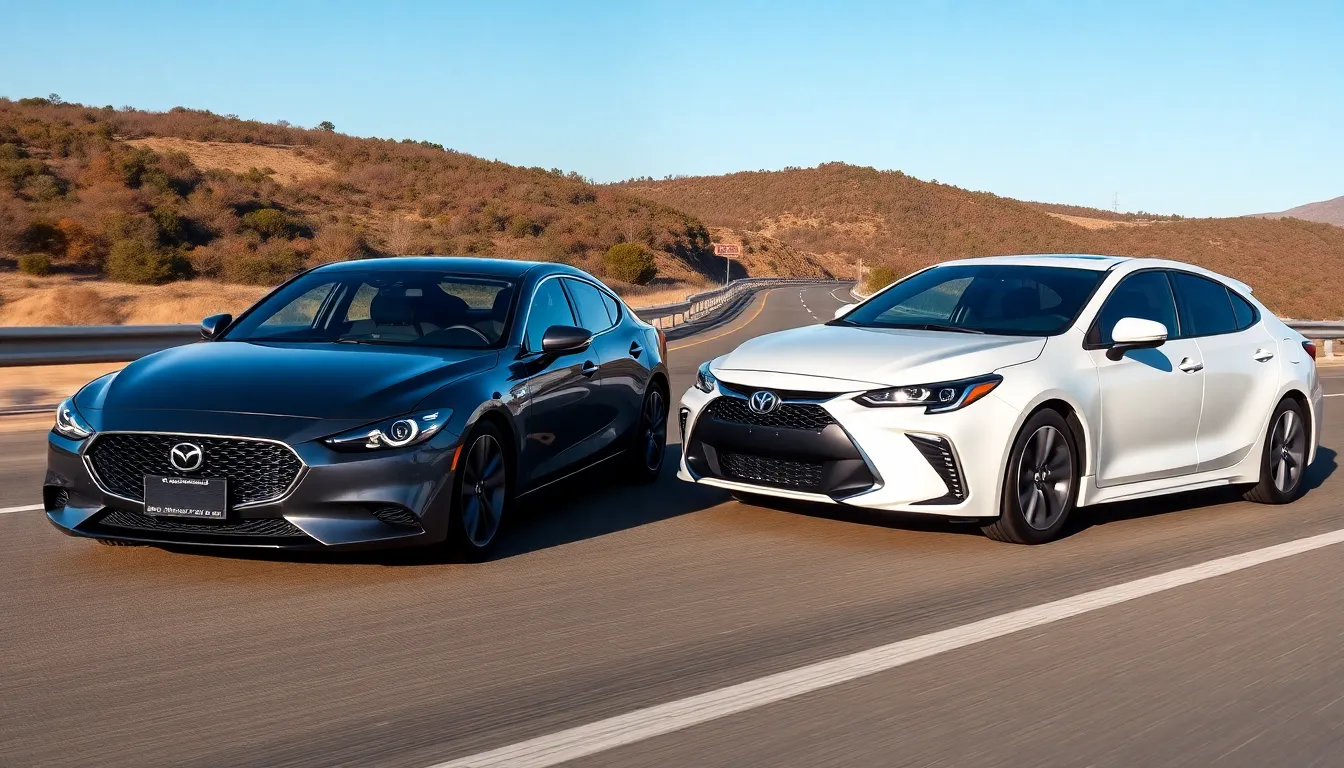
When comparing Mazda vs Toyota, understanding the total cost of ownership provides crucial insight beyond the sticker price. This comprehensive analysis examines what you’ll actually spend throughout your vehicle ownership journey.
Initial Purchase Price
Mazda vehicles typically offer a lower starting MSRP than comparable Toyota models, with price differences often reaching thousands of dollars across various segments. This initial affordability makes Mazda an attractive option for budget-conscious buyers seeking premium features without the premium price tag. Toyota prices tend to be higher at purchase, though they remain competitive within their respective vehicle classes and often include more standard features that might be optional on Mazda models.
Fuel Economy
Both manufacturers produce vehicles with respectable fuel efficiency, but Toyota holds a distinct advantage in this category. Toyota’s extensive hybrid lineup delivers exceptional fuel economy that translates to important savings at the pump over time. While Mazda focuses on creating responsive driving dynamics through their innovative Skyactiv technology, they lack the diverse hybrid options that make Toyota a fuel economy leader. For daily commuters concerned about ongoing fuel costs, Toyota’s hybrid technology often proves more economical even though the higher initial investment.
Maintenance and Repair Costs
Toyota edges out Mazda with slightly lower maintenance expenses, averaging $441 annually compared to Mazda’s $462. This small difference compounds over years of ownership and becomes more noticeable when considering parts availability and service costs. Toyota’s widespread dealer network and abundant aftermarket parts often result in more affordable repairs when needed. Insurance costs also favor Toyota, with average annual premiums of $1,468 versus Mazda’s $1,608, adding another dimension to ongoing ownership expenses.
Resale Value
Toyota vehicles consistently outperform Mazda in holding their value over time, a important factor when calculating true ownership costs. This superior resale value stems from Toyota’s reputation for exceptional longevity, with many vehicles remaining reliable well beyond 200,000 miles and sometimes exceeding one million kilometers. The five-year cost of ownership calculations reveal this stark difference: a 2025 Mazda CX-5 costs between $46,957 and $55,336 over five years, while a comparable 2025 Toyota Cross ranges from $37,425 to $44,000. This substantial difference of nearly $10,000 in total ownership costs demonstrates why Toyota often represents better long-term value even though higher initial prices.
Model Lineup Comparison
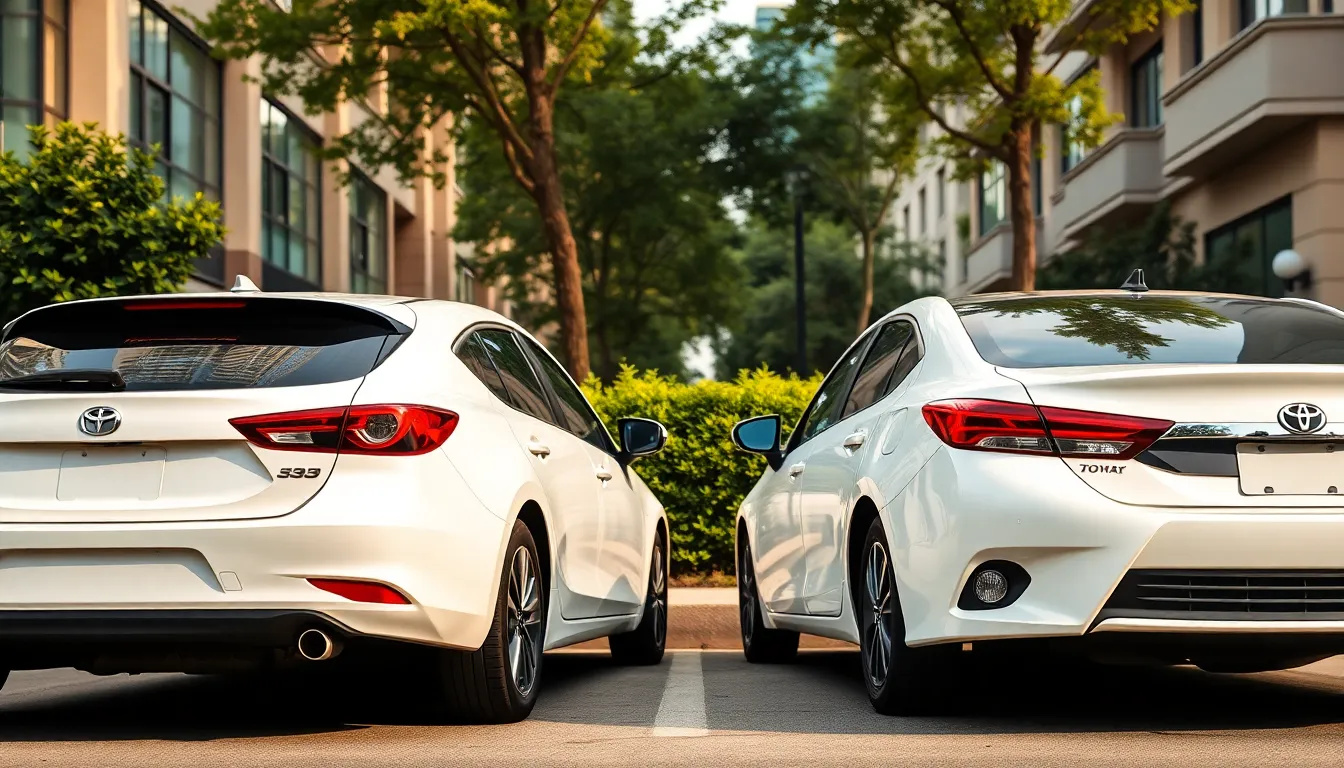
When comparing Mazda vs Toyota, their vehicle selections reflect distinctly different brand philosophies and market approaches. Each manufacturer offers unique strengths across various vehicle categories that appeal to different types of drivers.
Sedans and Hatchbacks
Mazda’s sedan and hatchback lineup centers around the Mazda3, available in both body styles with pricing starting around $25,135. The Mazda3 hatchback provides cargo space comparable to some small SUVs while delivering a markedly sportier driving experience. Driving enthusiasts particularly appreciate Mazda’s commitment to captivating performance, with tighter handling, sport-tuned suspensions, and the increasingly rare option of a six-speed manual transmission. These performance-oriented features make Mazda sedans and hatchbacks stand out for drivers who prioritize road feel and responsiveness.
Toyota counters with its popular Corolla lineup, offering both sedan and hatchback variants starting at approximately $24,975. Toyota’s approach to smaller vehicles emphasizes comfort over sportiness, featuring softer handling characteristics and fewer manual transmission options. The Corolla hatchback has earned a reputation for excellent resale value retention, making it an attractive long-term investment for practical buyers. Toyota sedans generally appeal to drivers seeking reliability and comfort rather than ever-changing driving experiences.
SUVs and Crossovers
Mazda currently offers up to five SUV and crossover models, focusing on quality over quantity. These vehicles maintain the brand’s commitment to balanced fuel efficiency without sacrificing the sporty driving dynamics Mazda is known for. A important advantage in Mazda’s crossover lineup is the widespread availability of i-Activ AWD, which comes standard on more models, improving traction in challenging conditions without requiring additional purchases. Mazda’s crossovers deliver a more connected driving experience than many competitors in the same segments.
Toyota presents a substantially broader SUV lineup with up to 15 different models, covering virtually every market segment and size category. This extensive range includes traditional gasoline models alongside hybrid, plug-in hybrid, and fully electric options. Toyota SUVs prioritize practicality, passenger comfort, and versatility across their various powertrains. This comprehensive approach allows Toyota to cater to nearly any SUV buyer’s exact needs, from urban commuters to large families requiring maximum space and capability.
Trucks and Specialty Vehicles
Mazda has completely withdrawn from the truck market in the United States, with the Mazda B-Series pickup being their last offering in this segment. Currently, Mazda offers no pickup trucks or minivans in the American market, instead focusing their resources on perfecting their car and crossover lineup. This strategic specialization allows Mazda to concentrate on their core strengths rather than competing in every vehicle category.
Toyota maintains a strong presence in specialty vehicles, offering multiple pickup truck options including the midsize Tacoma and full-size Tundra. Also, Toyota continues to serve the family market with the Sienna minivan. This diverse specialty vehicle lineup demonstrates Toyota’s commitment to providing options across virtually all major automotive segments. Toyota’s trucks, in particular, enjoy strong reputations for durability and capability, making them popular choices for both work and recreational use.
Mazda Advantages
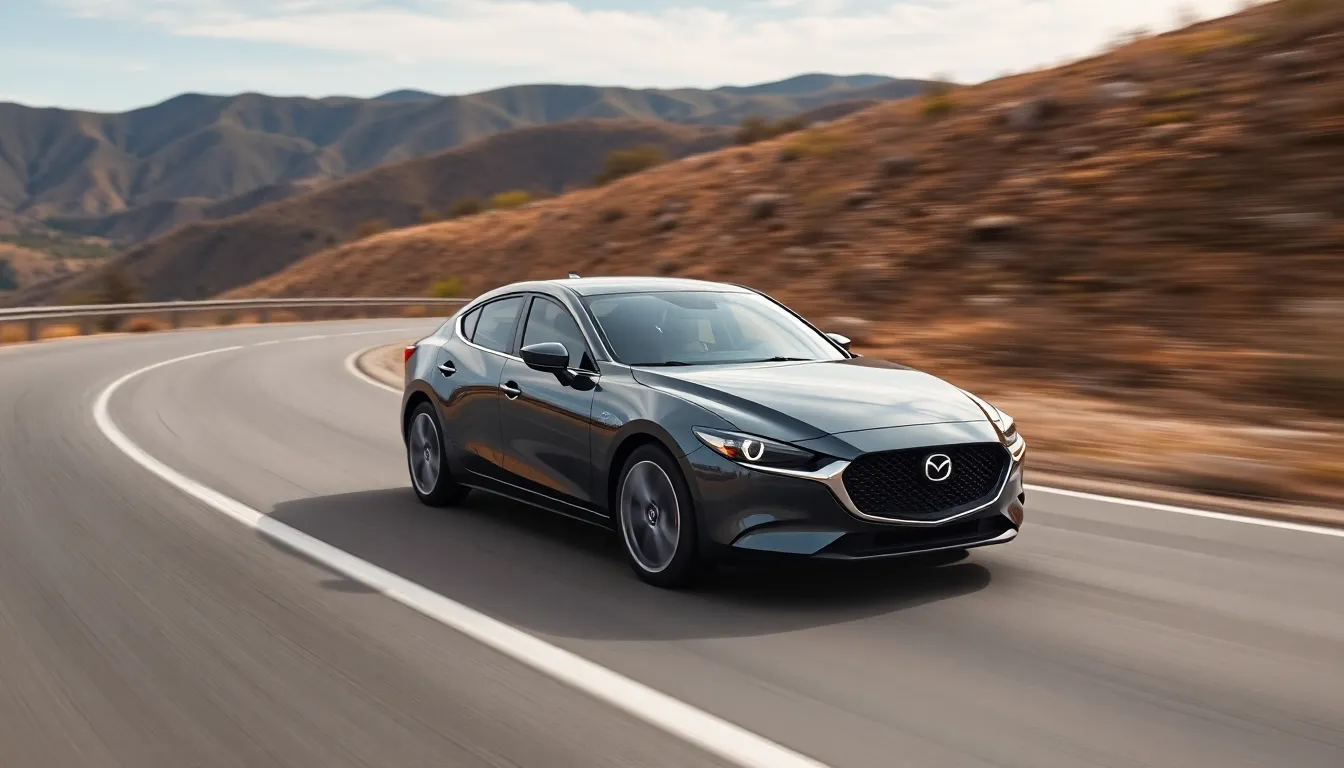
Performance enthusiasts often gravitate toward Mazda vehicles for their exceptional driving dynamics. Mazda has cultivated a reputation for creating cars that deliver a more captivating experience behind the wheel compared to Toyota’s offerings. The lightweight design philosophy employed across Mazda’s lineup contributes significantly to their nimble handling characteristics and responsive steering feedback.
Mazda’s turbocharged engine options, particularly in models like the CX-50, provide impressive power that satisfies drivers seeking a more spirited performance. The precision-tuned suspensions found in Mazda vehicles create a balanced ride that remains composed through corners while maintaining reasonable comfort for daily driving.
Design aesthetics represent another area where Mazda distinguishes itself in the Mazda vs Toyota comparison. Mazda’s commitment to elegance is evident in their “Kodo: Soul of Motion” design language, which has produced some of the most visually striking vehicles in their respective segments. The premium interior materials and thoughtful cabin layouts elevate the perceived value of Mazda vehicles beyond their price points.
Mazda’s fuel efficiency advantages stem from their innovative engineering approach. The brand’s focus on lightweight construction not only improves handling but also contributes to better fuel economy across their lineup. This efficiency-minded design philosophy helps reduce lifetime ownership costs even though competing with Toyota’s renowned hybrid technology.
Maintenance considerations favor Mazda in certain aspects as well. Industry data suggests Mazda vehicles typically experience fewer severe repair issues over time compared to industry averages. This reliability factor combined with competitive maintenance costs makes Mazda ownership surprisingly economical for drivers who appreciate the brand’s performance-oriented character.
Toyota Advantages
Toyota has established itself as a powerhouse in the automotive industry with several key advantages over competitors like Mazda. Their exceptional fuel efficiency stands out prominently, particularly with their pioneering hybrid technology that consistently delivers superior miles per gallon. The 2025 Toyota RAV4 with front-wheel drive achieves an impressive 27 mpg city and 35 mpg highway, outperforming comparable Mazda models in fuel consumption.
Interior comfort represents another important Toyota strength. Their vehicles typically feature more spacious cabins with generous headroom and legroom for both front and rear passengers. Toyota designs prioritize practical comfort with ample cargo capacity, making them ideal for families and those who value versatility in their daily driving needs.
Ride quality distinguishes Toyota vehicles in the Toyota vs Mazda comparison. Toyota opts for softer suspension tuning that creates a smoother, more comfortable driving experience particularly suited for long highway journeys and daily commuting. This comfort-oriented approach contrasts with Mazda’s sportier suspension that sacrifices some ride plushness for handling precision.
Toyota offers flexible all-wheel drive options across much of its lineup. You can select AWD capability on many models as an available upgrade based on your exact needs and budget. This approach differs from Mazda’s strategy of making AWD standard on many trims, giving Toyota buyers more configuration flexibility.
The reliability reputation Toyota has built over decades remains one of its strongest selling points. Their vehicles consistently rank among the most dependable in the industry, with many Toyota models capable of surpassing 200,000 miles with proper maintenance. This proven longevity translates directly to stronger resale values and lower overall ownership costs compared to many competitors including Mazda.
| Aspect | Toyota Advantage | Benefit to Owners |
|---|---|---|
| Fuel Economy | Superior hybrid technology | Lower fuel costs over vehicle lifetime |
| Interior Space | Roomier cabins, larger cargo areas | Greater versatility for families and activities |
| Ride Quality | Smoother, comfort-focused suspension | Reduced driver fatigue on long trips |
| AWD Availability | Optional on many models | Customizable based on needs and budget |
| Long-term Reliability | Vehicles regularly exceeding 200,000 miles | Higher resale value, lower lifetime ownership costs |
Toyota’s comprehensive safety technology further strengthens its position. Their Safety Sense package comes standard on virtually all new models, providing advanced driver assistance features that protect occupants while improving driving confidence. This commitment to making advanced safety accessible across their entire lineup demonstrates Toyota’s focus on practical value rather than reserving key features for premium trims.
Real Owner Experiences
When comparing Mazda vs Toyota, understanding the experiences of actual owners provides valuable insights beyond specifications and expert reviews. These firsthand accounts reveal how these vehicles perform in daily life and highlight the aspects owners appreciate most about their chosen brand.
Mazda Owner Feedback
Mazda owners consistently praise their vehicles for delivering an captivating driving experience that stands out in the automotive market. The brand’s “Zoom-Zoom” philosophy translates into real-industry satisfaction with owners frequently highlighting the sporty handling and responsive steering that makes daily commutes more enjoyable. Many Mazda enthusiasts appreciate the elegant design elements and upscale interior quality that provides a premium feel without the luxury price tag. According to reliability data, Mazda owners experience a slightly lower rate of severe repairs (10%) compared to Toyota owners, suggesting fewer major mechanical issues. The SKYACTIV technology and i-ACTIV AWD system receive particular acclaim from drivers who value both performance and efficiency. Maintenance costs represent another bright spot for Mazda ownership with average annual repairs around $462—below the industry average and potentially lower than Toyota’s maintenance expenses.
Toyota Owner Feedback
Toyota owners typically emphasize reliability and practicality as the primary benefits of their vehicles. The confidence that comes with Toyota’s reputation for longevity resonates strongly with owners who plan to keep their vehicles for many years. Family-friendly features and spacious interiors earn high marks from parents and those who regularly transport passengers or cargo. Toyota’s pioneering hybrid technology generates enthusiastic feedback from owners who appreciate the impressive fuel economy and environmental benefits. Safety-conscious drivers value Toyota’s comprehensive safety systems, with more models earning IIHS Top Safety Pick+ designations than Mazda. While Toyota owners experience a slightly higher rate of severe repairs (12%) compared to Mazda owners, they often report exceptional longevity with proper maintenance. Many Toyota enthusiasts note that although parts cost about 27% more than Mazda components, they appreciate that Toyota vehicles typically require fewer repair shop visits, suggesting better long-term dependability even though the higher part costs when service is needed.
Final Verdict: Which Brand Is Right for You?
Choosing between Mazda and Toyota eventually depends on your priorities behind the wheel. If you value spirited driving dynamics premium interiors and distinctive styling without luxury pricing Mazda delivers an captivating ownership experience with improved reliability ratings.
Toyota remains the practical choice for buyers prioritizing long-term dependability fuel efficiency especially with hybrid options and strong resale value. Their vehicles excel in comfort spaciousness and offer comprehensive safety features across a wider model range.
Both manufacturers produce quality vehicles that stand the test of time. Mazda speaks to driving enthusiasts seeking a more emotional connection while Toyota appeals to pragmatic buyers wanting hassle-free ownership. Your ideal choice depends on whether you prioritize the journey or the destination in your driving experience.
Frequently Asked Questions
Which brand has better reliability, Mazda or Toyota?
Recent assessments indicate that Mazda has a slight edge in reliability statistics, though Toyota maintains its legendary status for long-term dependability. Both brands build vehicles that can last well beyond 200,000 miles with proper maintenance. Toyota has historically set the industry standard for reliability, while Mazda has made significant improvements in recent years to close the gap.
How do Mazda and Toyota compare in terms of driving experience?
Mazda prioritizes an engaging driving experience with sport-tuned suspension and responsive steering, making their vehicles more fun to drive. Toyota focuses on comfort, smooth ride quality, and predictable handling. If you enjoy a more connected driving feel, Mazda will likely be more satisfying, while Toyota excels in providing a relaxed, comfortable driving experience.
Which brand offers better fuel efficiency?
Toyota has a clear advantage in fuel efficiency, particularly with its extensive hybrid lineup. Models like the Prius and hybrid versions of the Corolla, Camry, and RAV4 deliver exceptional miles per gallon. While Mazda’s Skyactiv® technology provides competitive fuel economy for non-hybrid vehicles, Toyota’s hybrid powertrains generally offer superior efficiency that translates to significant long-term savings.
Are Mazdas or Toyotas more affordable to own long-term?
Toyota vehicles typically have lower total cost of ownership despite higher initial purchase prices. This advantage comes from Toyota’s superior fuel efficiency, lower maintenance costs, and stronger resale values. Mazda vehicles often have lower starting MSRPs, making them attractive initially, but Toyota’s long-term value proposition generally results in better financial outcomes over a 5-year ownership period.
Which brand has better safety features?
Both brands excel in safety with comprehensive driver assistance packages. Toyota’s Safety Sense comes standard on most models and includes features like pre-collision braking and lane departure alerts. Mazda’s i-Activsense offers similar capabilities with a focus on enhancing driver control. Both brands consistently earn high safety ratings, with numerous models receiving IIHS Top Safety Pick and Top Safety Pick+ designations.
How do the interiors compare between Mazda and Toyota?
Mazda offers more upscale interiors with premium materials, elegant designs, and driver-focused layouts even in their entry-level models. Toyota interiors tend to be more practical and durable with straightforward controls and layouts. If interior aesthetics and quality are priorities, Mazda generally provides a more premium experience without the luxury price tag.
Which brand offers better technology features?
Mazda’s infotainment system features high-resolution displays with a command knob controller that many find intuitive during driving. Toyota has improved its systems significantly, offering responsive touchscreens and advanced connectivity options. Both provide smartphone integration, but Toyota’s systems are sometimes more user-friendly while Mazda’s approach feels more premium and less distracting.
Do Mazda or Toyota vehicles hold their value better?
Toyota vehicles typically maintain stronger resale values over time. Their reputation for reliability and broad market appeal helps Toyota models retain approximately 5-10% more of their value after five years compared to similar Mazda models. This advantage in depreciation represents a significant factor in Toyota’s better long-term ownership value proposition.
Which brand is better for families?
Toyota generally offers more family-friendly features with spacious interiors, generous cargo capacity, and practical designs. Models like the RAV4, Highlander, and Sienna provide excellent versatility for families. While Mazda vehicles like the CX-5 and CX-9 offer competitive space and safety, Toyota’s lineup includes more options specifically designed with family needs in mind.
Should I choose Mazda or Toyota if I want a hybrid vehicle?
Toyota is the clear choice for hybrid technology with its extensive lineup of hybrid models and decades of experience perfecting this technology. From the iconic Prius to hybrid versions of popular models like Corolla, Camry, RAV4, and Highlander, Toyota offers proven hybrid powertrains with exceptional reliability. Mazda has been slower to adopt hybrid technology, with fewer options currently available.
Related Posts:
